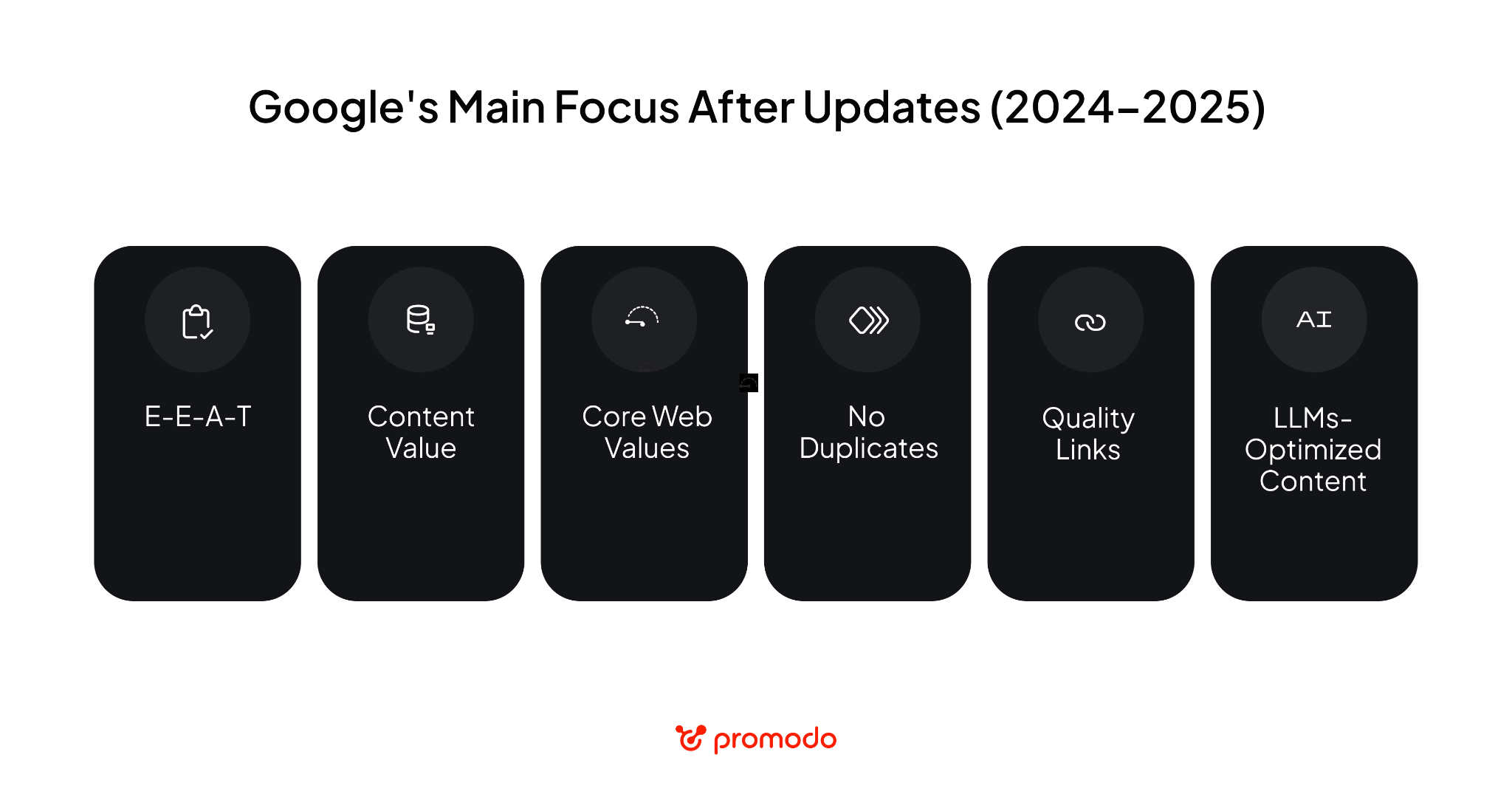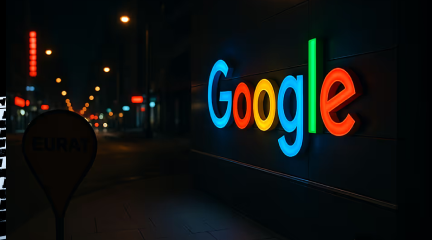Content
.png)
In 2024–2025, Google radically revised its website ranking principles. If your website is losing traffic and positions, it has probably been penalized and no longer meets the requirements.
In this article, we’ll explore how to recover your website’s visibility after being hit by a Google penalty — in other words, how to tweak your approach to Search Engine Optimization(SEO) to meet the new standards.
In 2024 alone, Google released at least five major updates, and in June 2025, it released a fundamental AI-first Core Update that completely changed the principle of content evaluation.

Below is a brief overview of the key changes:
The update removed up to 40% of non-original or duplicate content, even affecting large media outlets and marketplaces. The algorithm focused on author experience, truthfulness, and usefulness, finally shifting the emphasis to E-E-A-T. Technical optimization no longer saves the day — real expertise and practical experience are what matter.
Google has updated its SpamBrain spam detection system. Websites with fake FAQs, fake reviews, and date updates without content changes have been targeted. The algorithm has become more accurate in detecting SEO approaches designed for bots rather than humans.
Google changed its approach—instead of “punishing” sites, it gave those with a consistent focus, usefulness, and high-quality UX a chance to regain their positions. Niches with clear themes and logical structures came out on top. Sites with a “one size fits all” approach continued to lose credibility.
Google has removed over-optimized texts, hidden advertising, and content “for ranking” from its search results. Poor UX — pop-up banners, slowness, complex navigation — has become a direct signal for lowering rankings. Behavioral factors are now the focus of attention.
The Helpful Content System has become part of the core algorithm. Google evaluates each page separately: weak content no longer drags down the entire site, but even a strong page cannot save the overall picture. Systematic work with all content and clear structuring according to E-E-A-T is necessary.
MUVERA and Google Fact Model have changed their approach to ranking: it is not only relevance that matters, but also depth, reliability, and originality. With AI Overviews, SEO has to adapt — now the main goal is to become a source on which AI builds its answers.
Promodo's SEO specialists are currently working on restoring traffic for many clients. Google has released many algorithm updates, but has not released clear instructions on how to restore traffic, so getting out from under the filter is currently a matter of testing hypotheses. Our experience shows that the following steps work:
After the Link Spam Update, the SpamBrain algorithm learned to detect low-quality links. If you previously purchased backlinks en masse from drop domains, PBN networks, or sites without organic traffic, these links are now likely working against you.
As part of traffic recovery, we conduct a full audit of the link profile using Ahrefs, Serpstat, Majestic, and Google Search Console. We check the Domain Rating, donor traffic, the ratio of incoming and outgoing links, the anchor profile, the frequency of links, and the subject matter of the resource.
We ruthlessly remove (using Google Disavow Tool) all links from drops, sites with DR < 30, and sources without organic traffic (less than 50 sessions/month). At the same time, we gradually replace them with links from real media, niche forums, partner sites, or thematic resources with traffic of more than 50–200 thousand users. Preference is given to non-anchor or branded links.
It is important to note that the result is not instantaneous. After cleaning and repurchasing, changes are visible no earlier than in 3–4 months. But it is this stage that is often decisive for traffic to start recovering.
Filters are a powerful SEO tool if used correctly. In previous years, a popular strategy was to open as many filters as possible for indexing, cover all combinations of the type “product + brand + model,” and cover as many key queries as possible. After the Helpful Content and Link Spam Update, this practice is no longer effective.
Today, Google clearly filters pages that are irrelevant to the user. If a filter page has no traffic, contains 1–2 products, and the query is low-frequency or artificial, it potentially reduces the authority of the entire category.
We recommend leaving only those filters in open access that have a search frequency of more than 50 queries per month, a stable availability of products (at least 3-5), and a clear search intent. It is also important that filter combinations form unique pages with relevant SEO texts, metadata, and a logical URL structure.
For the most frequent filters, it is advisable to prepare unique texts — with descriptions of categories, applications, brands, and product models. This meets the E-E-A-T requirements for content depth.
If pages load slowly, are not indexed, or are blocked by JavaScript, SEO texts will not save the situation. One of the most common problems on eCommerce sites is dynamic content generation via external databases or APIs. In such cases, Googlebot only sees an “empty” structure, without products, filters, or navigation.
The solution is to implement Server-Side Rendering (SSR) — server-side HTML generation, which allows the search engine to immediately receive a full version of the page. This radically improves the indexing of categories and filters. In addition to SSR, it is worth implementing caching of ready-made page fragments to ensure fast loading even under high load. Google pays attention to Core Web Vitals, in particular INP (Interaction to Next Paint) and FCP (First Contentful Paint), and slow pages do not receive any ranking advantages.
In practice, we have repeatedly seen situations where, after switching to SSR, pages began to be indexed, even if they were not previously included in search results at all. This is especially true for large catalogs where content is generated from APIs and is not stored as static pages.
The structure of the site is another factor that directly affects crawl budget, weight transfer, and indexing. Problems often arise due to duplicate categories, chaotic URL formation, or ill-conceived links between pages.
One of the most effective approaches is to completely rebuild the hierarchy of categories and subcategories, taking into account the semantics and actual structure of the product catalog. For example, if there is a category called “Shock Absorbers” and it has a subcategory with the same name, both pages will compete with each other for the same queries. The solution is to leave one relevant page and redirect the rest to it with a 301 redirect.
We also recommend getting rid of duplicate brand pages that don't have any content. Instead of just listing products, we create brand pages with more info: company history, product features, answers to common questions, and logical links to categories and models. This turns the brand page into a full-fledged SEO asset.
At this stage, it is advisable to update the CMS. A modern content management system should allow flexible management of filters, metadata, feeds for marketplaces, content blocks, and technical parameters for SEO. It is desirable that it includes integration with search engines via API, XML file generation, and the ability to customize robots.txt and sitemap.xml.
Even well-written content has a “shelf life.” Since the introduction of the Helpful Content System, Google's algorithms have been increasingly strict in evaluating the relevance and usefulness of content. If a category or product page has not been updated for years, this is a signal to the algorithm that the site is inactive. We systematically review the texts on key pages (categories, brands, filters), check their compliance with current semantics, and adapt them to search queries that have appeared or changed in recent months.
For example, if new car models or spare parts have appeared, we add the corresponding query combinations to the texts, heading structure, and internal linking. Often, it is precisely these “long-tail” queries — “[spare part] + [brand] + [model]” — that bring high-conversion traffic.
Important: texts are not just added — they are tested and checked in Serpstat, Ahrefs, or Semrush for frequency and competition, and only then are they launched.
We also periodically update meta title tags, meta descriptions, alt texts for images, and add relevant key phrases to H2/H3 headings. This gives a boost to reindexing and often has a positive effect on position dynamics.
Read more about how to update content correctly.
E-E-A-T (Experience, Expertise, Authoritativeness, Trustworthiness) became one of the main paradigms in 2024–2025. For commercial websites, it manifests itself not only through text, but also through all accompanying elements of the page: contacts, details, delivery terms, return policies, brand mentions in external sources, the presence of authors with expertise, etc.
We actively integrate blocks with brand descriptions, add “About Us” pages, make contacts transparent, and strengthen links to social networks.
Technically, this is accompanied by Schema markup of the Organization, Person, Product, Review, and FAQ types, which allows information to be presented to the search engine in a structured way.
We pay special attention to category and brand pages: we add information about manufacturers, links to official websites, mentions in the media or niche sources. All this increases the credibility of the page from Google's point of view and increases the likelihood of its ranking.
Below are examples from Promodo's practice, where we helped large retailers recover their visibility through technical changes, link profile cleaning, and content work.
After the 2023 Link Spam Update, the site lost 37% of its organic traffic. The main reason was backlinks from over 800 drop domains, over 1 million technical duplicates, and an oversaturated structure.
What we did:
The result:
After 12 months, organic traffic exceeded pre-update traffic by 10%. The share of keywords in the TOP 3 increased from 3% to 25%, the site regained the trust of search engines and occupied stable positions.
In this project, we focused exclusively on link quality. The site had unstable dynamics, with signs of filtering due to a manipulative backlink profile. The task was to clean up the links without purchasing new ones, only replacing them with high-quality resources.
What was done:
The result:
After 4 months — stable growth in organic traffic, positive dynamics in search positions, gradual removal of Google sanctions. The site began to rank again in target categories without any losses after new updates.
More SEO case studies here.
SEO in 2025 is a dynamic process where every change in the algorithm can change the rules of the game. Currently, the rules are as follows:
☐ Clean up links
☐ Build a logical structure
☐ Optimize technology, speed, and UX
☐ Work with filters and semantics
☐ Invest in expertise and useful content
And most importantly — test. The results may be unexpected, but only those who continue to act will achieve high positions.
If your website has also suffered after the updates, our SEO experts are ready to develop a customized strategy for you. We know how to adapt to Google's algorithms because we have already done so for dozens of projects in various niches.
You may also like
Choose quality and trusted services to improve the presence of your company on the Internet, and feel free to contact our UK team if you have any questions.

In 2024 and early 2025, we saw several major algorithm updates that changed the rules of the game for SEOs, content marketers, and website owners.
.avif)
In early 2020 we were sure that the COVID pandemic changed our lives forever. This seemed a horrific situation for the world economy.

While some 87% of the US population go online to choose healthcare providers, effective patient acquisition requires consistent marketing strategy.

Instability in search results has become the new normal: numerous Google updates, personalized SERPs, increasing AI influence, and declining CTRs...
We at Promodo are ready to help you improve your performance across all digital marketing channels.
Get started
